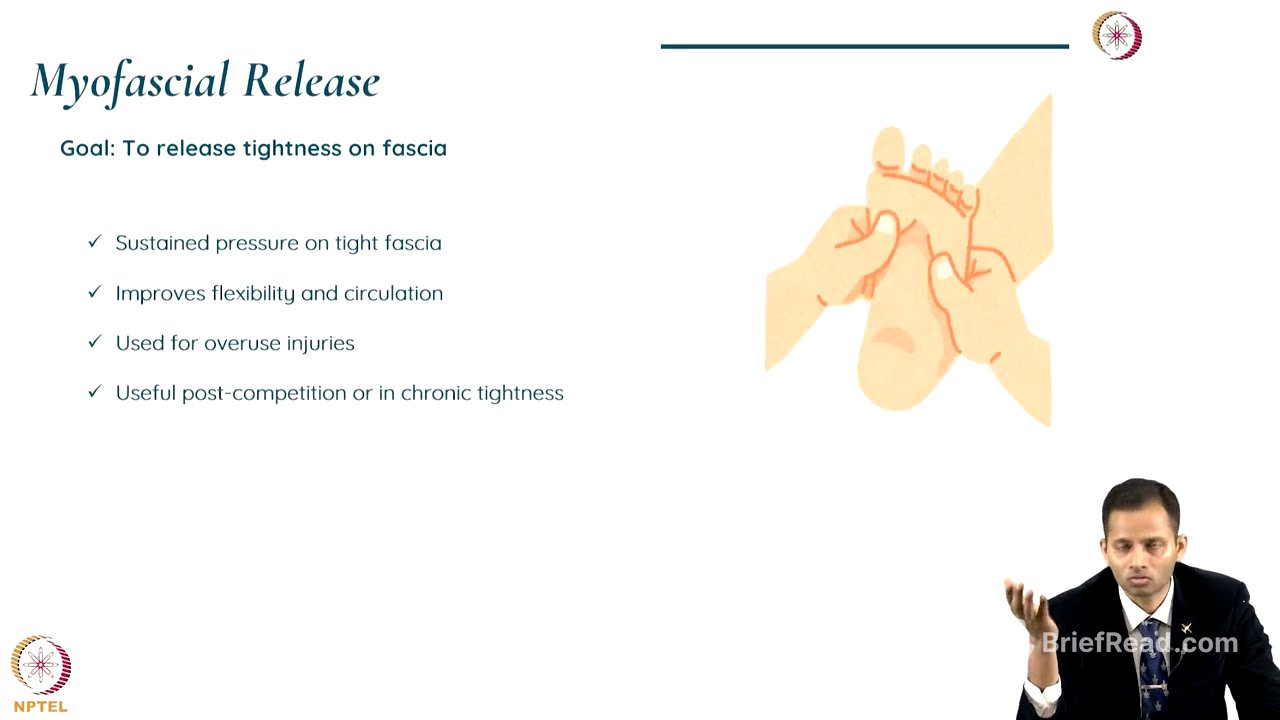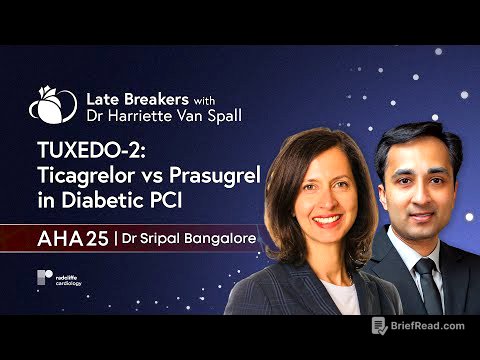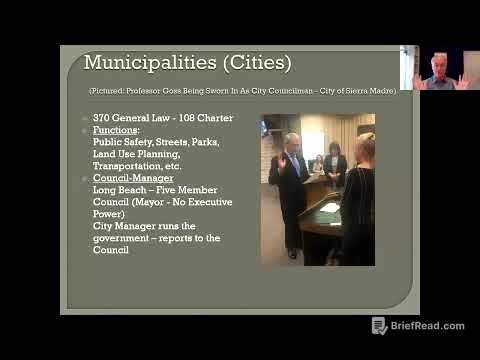TLDR;
This lecture explores the use of alternative therapies in sports rehabilitation, emphasizing their role in accelerated recovery and holistic healing. It covers various alternative therapies, including manual therapies like myofascial release, mind-body practices such as acupuncture, cupping therapy, aromatherapy, yoga, meditation, biofeedback, and aquatic therapy. The lecture underscores the importance of integrating these therapies with traditional rehabilitation methods, considering scientific evidence, clinical experience, and athlete preferences to create a comprehensive, athlete-centered treatment plan.
- Alternative therapies complement conventional rehab programs, focusing on whole-body healing.
- Key therapies discussed include myofascial release, acupuncture, cupping, aromatherapy, yoga, meditation, biofeedback, yog nidra, and aquatic therapy.
- Effective integration requires scientific rationale, clinical experience, and consideration of athlete needs.
Introduction: Alternative Therapies in Sports Rehabilitation [0:15]
The lecture begins by introducing the concept of using alternative therapies to aid faster recovery in sports-related injuries, using the example of Raini, a volleyball player with a twisted ankle. It highlights the shift towards mind-body integration and athlete-centered, evidence-based practices in sports medicine. The discussion aims to explore the principles, rationales, and evidence behind incorporating alternative therapies into sports rehabilitation, with a focus on a multimodal approach and practical application through case scenarios.
The Need for Alternative Therapies [2:05]
The rehabilitation process has evolved to include complementary therapies, focusing not only on physical treatment but also on mind-body integration and holistic recovery. Alternative therapies complement conventional rehab programs by promoting healing and enhancing mind-body interaction, which is beneficial for the athlete's overall recovery. Athletes are increasingly seeking and experimenting with these therapies to expedite their return to sports, reduce pain and inflammation, improve recovery, enhance performance, and promote mental wellness.
Categories of Alternative Therapies [5:12]
Alternative therapies can be broadly categorized into manual therapies, mind-body practices, energy-based methods, and natural remedies. The lecture will focus on specific therapies that have shown effectiveness in faster rehabilitation, based on experience and successful incorporation into treatment plans.
Myofascial Release [5:57]
Myofascial release is a manual therapy that targets tightened fascia to improve biomechanical force transfer, reduce pain, and alleviate spasms. Therapists use their fingers, elbows, or instruments to apply sustained pressure on the tightened areas, improving flexibility and circulation. It is commonly used for overuse injuries and post-competition soreness, especially in cyclical sports like cycling or running.
Acupuncture and Dry Needling [7:12]
Acupuncture, an ancient Chinese therapy, involves inserting fine needles into specific meridians to release endorphins, reduce spasms, and alleviate swelling. It is widely accepted and integrated into post-surgical rehabilitation, with evidence supporting its effectiveness in reducing myofascial pain. Dry needling, a westernized concept, uses thin monofilament needles to reduce pain in myofascial trigger points and taut bands by stimulating free nerve endings and releasing local chemicals. It is effective for chronic low back ache, neck, and shoulder pain.
Cupping Therapy [9:21]
Cupping therapy involves creating a vacuum force using cups on the skin, causing small vessels to rupture and form erythema. This ancient technique includes dry cupping (non-invasive suction) and wet cupping (making a slit in the skin to extravasate blood). It is commonly used for chronic soft tissue pain, with the pain gate theory and nitric oxide release proposed as mechanisms for pain relief and increased blood flow.
Aromatherapy [10:48]
Aromatherapy enhances mental and physical balance by using essential oils to induce sleep, relaxation, and pain reduction. It is particularly useful for high-stress and anxious individuals, such as athletes missing critical competitions due to injury. Popular scents include lavender, peppermint, and eucalyptus, used in massage oils or air diffusers.
Yoga and Mobility Work [11:55]
Yoga involves structured and disciplined movements that improve joint mobility and muscle strength. It integrates mind and body through synchronized breathing and movement, promoting flexibility, balance, and core stability. Yoga enhances focus, relaxation, and motor control, reducing injury risk and is widely used in sports as a recovery method and movement drill.
Meditation and Mindfulness [13:18]
Meditation and mindfulness help injured athletes by improving mental recovery, lowering stress hormones, increasing pain tolerance, and enhancing focus. These practices reduce anxiety, address fear of re-injury, and improve confidence, which helps athletes adhere to rehabilitation programs. Scheduled meditation and mindfulness practices can improve mental relaxation, develop endurance, and enhance sports performance.
Biofeedback [15:13]
Biofeedback establishes brain-body recovery using physiological parameters like EEG, EMG, and heart rate variability. This therapy provides real-time feedback on an individual's relaxation state and adaptation to training, fine-tuning the sports rehab program. It improves motor control, stress management, and neuromuscular coordination, particularly beneficial for ligament injuries and post-operative patients with muscle inhibition.
Yog Nidra [16:52]
Yog Nidra, an ancient technique promoting yogic sleep, enhances recovery by improving sleep quality. During this state, individuals are aware of their surroundings but in a low energy state, which facilitates learning, memory consolidation, and motor learning. It leverages the benefits of sleep for sports rehabilitation and performance, using guided instructions to achieve a state of deep relaxation while maintaining awareness. Evidence supports its use for better sleep, reduced stress, and anxiety in athletes.
Aquatic Therapy [18:50]
Aquatic therapy uses water as a medium to promote functional recovery and therapeutic exercises, reducing stress on weight-bearing joints. It is versatile for pediatric, orthopedic, neurological, and cardiopulmonary patients, requiring only a harness for safety. The depth of immersion varies the weight-bearing aspect, facilitating range of motion exercises and resistance training. Underwater treadmills and Tai Chi in the pool can further challenge balance and coordination, especially beneficial for older individuals.
Case Scenario: Applying Alternative Therapies [21:40]
The lecture revisits the case of Raini, the volleyball player, to illustrate the application of alternative therapies. For a suspected grade two ankle injury, an integrated approach includes cryotherapy, electrotherapy (IFT), taping, and aquatic therapy. Phase one involves pain relief and early mobility with whirlpools, joint mobilization, and relaxation techniques like aromatherapy or yoga nidra. Phase two focuses on pain control with acupuncture, improved motor control with balance exercises, biofeedback training, and pool-based isometric training.
Evidence-Based Practice and Considerations [25:05]
Choosing alternative therapies requires a scientific rationale and evidence-based practice, considering emerging evidence, clinical experience, and athlete needs. Safety and ethics are paramount, ensuring decisions are based on scientific rationale rather than emotions. Informed consent, certification in alternative therapies, and emphasis on professionalism and training are crucial. Therapeutic exercise remains the mainstay, with alternative therapies as additional tools to achieve rehabilitation goals.
Summary and Conclusion [28:27]
The integration of alternative therapies in clinical practice is essential, creating a multimodal hybrid rehabilitation program. Outcomes must be monitored and documented, incorporating athlete feedback. Team collaboration, tailored therapies, and understanding the demands of the sport are vital. A scientific understanding of these therapies, literature research, and synthesizing available evidence are necessary. The approach should always be grounded in evidence-based practice, considering patient care, evidence-based information, and clinical judgment.









